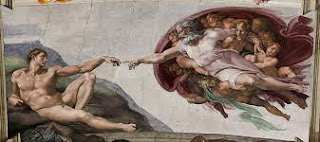Thota Laxminarayana - Meet the Artist
To find one’s own voice in the work that one creates is in
many ways to have finally arrived... To have your work be its own signature, to
have people look at a painting, and to recognize the ‘style’ as yours is a sure
indication that you have finally found your place in the scheme of things...
One such happy artist is the man who’s bringing rural India
to the urbane world very stylishly...Thota Laxminarayana.
Having spent a good part of his childhood in the villages of
Andhra Pradesh, Thota brings to us the brilliant, steamy summers of rural
India, with its vibrant colours and the idyllic innocence all wrapped up in a
fresh personal idiom. A self-taught artist, Thota has been creating art since the
age of eight, inspired by the Nirmal folk art that was all around him. “I used to paint
as a child but I was mostly active with other art forms. I used to act in
dramas, make paper jewellery, make clay idols and got into paintings very late.
I initially learned on my own from different artists but none taught me the
nuances. It was initially a struggle but then I met a person called ‘Guruji.’
Guruji is an expert in Nirmal work and I was blessed to learn a few things
under him in Adilabad,” says the artist.
Thus, hugely inspired by the local folk art, Thota
determined to pursue art as a full-time career, to keep the tradition alive
albeit in a new, contemporary avatar. While his earlier paintings, in oils and
acrylics, show some modelling and quieter colours, the artist has moved to
flatter applications of paint with forms defined solely by patterns. This is
not unlike the work of the Scottish contemporary artist Norman Gilbert, who aims
to “make each colour and shape enhance every other colour and shape so it’s
entirely satisfactory, so it’s at peace.”
While Norman's paintings (like the one above) usually depict the people around him and their ways, and the scenes from the life that he has lived over the last nine decades or so, Thota reaches into the
depths of memory for familiar forms and images of the countryside, of children playing in a village settings,
birds sitting on buffaloes, fishes swimming in swirling brooks, village folk
going about their business...all seemingly dressed up and ready to roll down the ramp in their new threads...enabling
a renewed appreciation for the commonplace. Where Norman's colours are more muted, the contrasts more controlled, Thota adopts a more strident colour palette, with a far simpler vocabulary of patterns, but with equally arresting appeal.
Always happy to make the acquaintance of a fellow artist, I was fortunate to get some answers from the ethnically grounded Thota Laxminarayana. Excerpts from an interview:
Q. Describe your typical working day.
A. My daily work routine is as same as everyone. I
work 8 to 10 hrs a day. And it goes on every day. (Waking up at 4 am each day)
Q. Why did you choose to be an artist?
A. Originally, I am from the Nirmal, of
Telangana. The atmosphere that I grew in was replete with art – Nirmal
paintings, toys and murals. In fact, the imagery of the tiger and deer was
painted on almost every home where I stayed. And what I saw in the form of folk
art, handicrafts and paintings inspired me to paint and draw.
Q. What is your goal as an artist?
A. Through my art I want to showcase our culture,
tradition in contemporary way. And making our next (future) generations not to
forget their culture and traditions.
Q. What inspires you to paint/create every day?
Q. What inspires you to paint/create every day?
A. The
cultural aspect of life is what inspires me to paint. In fact, my works are
documentaries of different people and aspects of life. For instance: the Duphliwala (drum player) series is an example of
what I aspire to paint. I feel there is a big need to document our culture and
I try to do this in my works.
Q. How do you choose your subjects?
Q. How do you choose your subjects?
A. My subjects are my childhood memories, the environment
I lived in, the things I saw and many more.
Q. Are you happy being an artist?
Q. Are you happy being an artist?
A. Yes. My biggest struggle was convincing my father
that I wanted to peruse art as a full-time career. And my father did not see
this as a secure future for me. But, once I started painting seriously and approaching galleries I became confident. I took steps
to move out of my village and find a footing in Hyderabad. I did face financial
issues but gradually these sorted out as I started painting with more
conviction and devotion.
Q. If you weren’t paid for it, would you
still paint/create?
A. Yes, I will paint. It has been my passion from my
childhood.
Q. What advice would you give to the aspiring
artists?
A. This
is a very good field. There are so many sources and many ways like Painting. Designing,
Sculpture, Textile designing, Advertising and more…
Q. What
have been the important turning points or influences in your artistic journey?
A. I think
there was no turning point for me. My artistic journey was slow and steady. I
just followed my heart throughout my journey.













Comments
Post a Comment